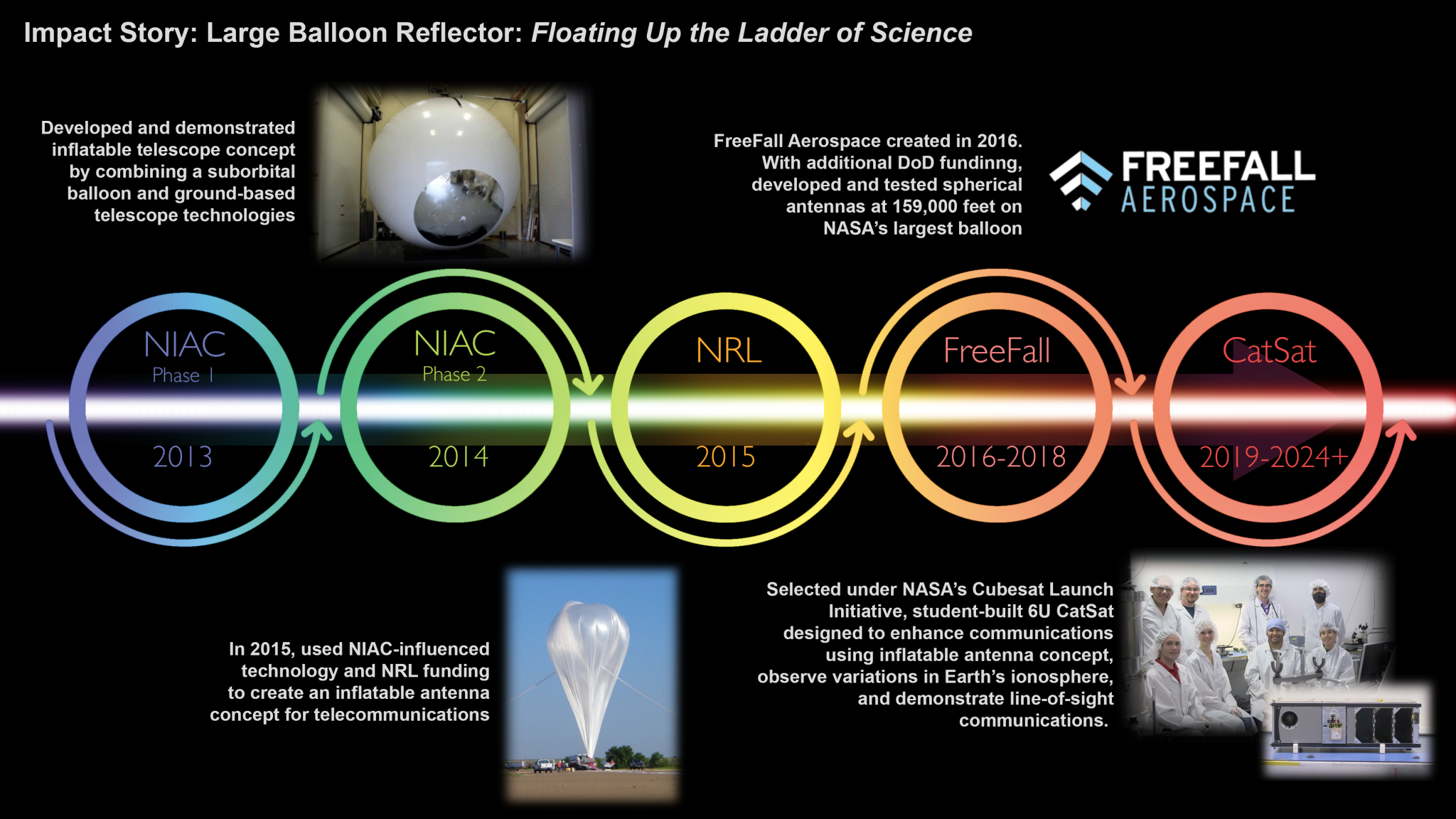NASA Tech Breathes Life Into Potentially Game-Changing Antenna Design
4 min read
NASA Tech Breathes Life Into Potentially Game-Changing Antenna Design

Some 30 years ago, a young engineer named Christopher Walker was home in the evening making chocolate pudding when he got what turned out to be a very serendipitous call from his mother.
Taking the call, he shut off the stove and stretched plastic wrap over the pot to keep the pudding fresh. By the time he returned, the cooling air in the pot had drawn the wrap into a concave shape, and in that warped plastic, he saw something – the magnified reflection of an overhead lightbulb – that gave him an idea that could revolutionize space-based sensing and communications.
That idea became the Large Balloon Reflector (LBR), an inflatable device that creates wide collection apertures that weigh a fraction of today’s deployable antennas. Now, with an assist from NASA’s Innovative Advanced Concepts (NIAC) program, funded by the agency’s Space Technology Mission Directorate, which supports visionary innovations from diverse sources, Walker’s decades-old vision is coming to fruition.
The concept turns part of the inside surface of an inflated sphere into a parabolic antenna. A section comprising about a third of the balloon’s interior surface is aluminized, giving it reflective properties.
With NIAC funding, and a grant from the U.S. Naval Research Laboratory, Walker was able to develop and demonstrate technologies for a 33-foot-diameter (10 meters) LBR that was carried to the stratosphere by a giant balloon. For comparison, the aperture of NASA’s massive James Webb Space Telescope is over 21 feet (6.5 meters) in diameter.
“There was no place other than NIAC within NASA to get this off the ground,” says Walker, now a astronomy and optical engineering professor at the University of Arizona in Tucson. “At first, I was afraid to share the idea with colleagues because it sounded so crazy. You need a program within NASA that will actually look at the radical ideas, and NIAC is it.”
Parabolic dish antennas use their concave shape to capture and concentrate electromagnetic radiation. The larger the antenna’s diameter, or aperture, the more effective it is for capturing light or radio waves and transmitting radio signals over great distances.
In astronomy, there is a tremendous advantage to placing telescopes above the Earth’s atmosphere, which tends to distort or degrade signals coming from space. The challenge is that traditional large reflector antennas are heavy, unwieldy, and difficult to stow, leading to launch constraints and risky in-space deployment schemes.
The LBR design solves both problems. Made of a thin film structure, it inflates like a beachball, providing a stable parabolic-dish shape without the need for bulky and complex deployable hardware, and can fold into a tiny volume.
In 2018, Freefall Aerospace, a company co-founded by Walker to develop and market the technology, demonstrated the LBR’s potential aboard NASA’s stadium-sized stratospheric balloon, which carried a 3.28-foot scale model to an altitude of 159,000 feet.
Next up for the technology is a high-speed communications demonstration in low Earth orbit aboard a 6-unit CubeSat, about the size of a shoebox, called CatSat. It was selected for flight in 2019 as part of NASA’s CubeSat Launch Initiative. It is a joint effort involving NASA, Freefall Aerospace, the University of Arizona, and Rincon Research Corporation in Tucson, Arizona.
After reaching low-Earth orbit, CatSat’s inflatable antenna deployment system will deploy from its container, inflate to a diameter of about one-and-a-half feet, and begin transmitting back high-definition Earth photos. The mission is slated for launch with several other CubeSats on Firefly Aerospace’s Alpha rocket as part of the Educational Launch of Nanosatellites (ELaNa) 43 mission.
A more ambitious lunar mission concept is also being explored. NASA’s Goddard Space Flight Center in Greenbelt, Maryland, would use the inflatable antenna in tandem with a new instrument called Terahertz Spectrometer for In-Situ Resource Utilization, a miniature, high-power laser precisely calibrated to detect water, a critical exploration resource.
“The technology demonstrated by CatSat opens the door to the possibility of future lunar, planetary and deep-space missions using CubeSats,” said Walker.
It might be difficult to believe this all started because a young engineer’s idea of dinner one evening was what most would consider dessert. Then again, one could say the proof was in the pudding.

Share
Details
Related Terms
First published at NASA.gov









